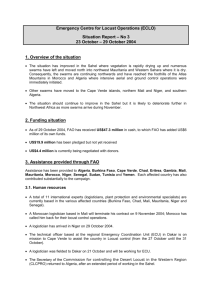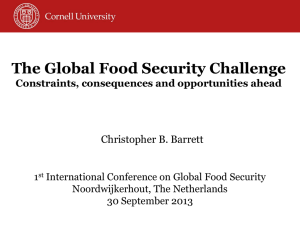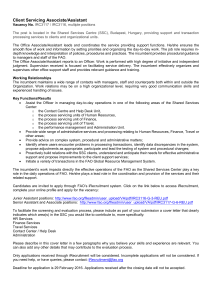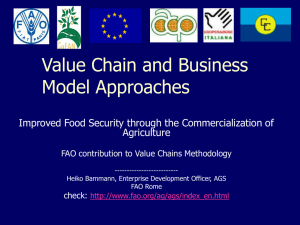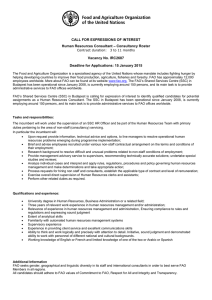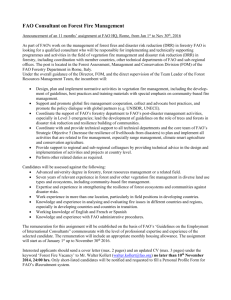english - Food and Agriculture Organization of the United Nations
advertisement
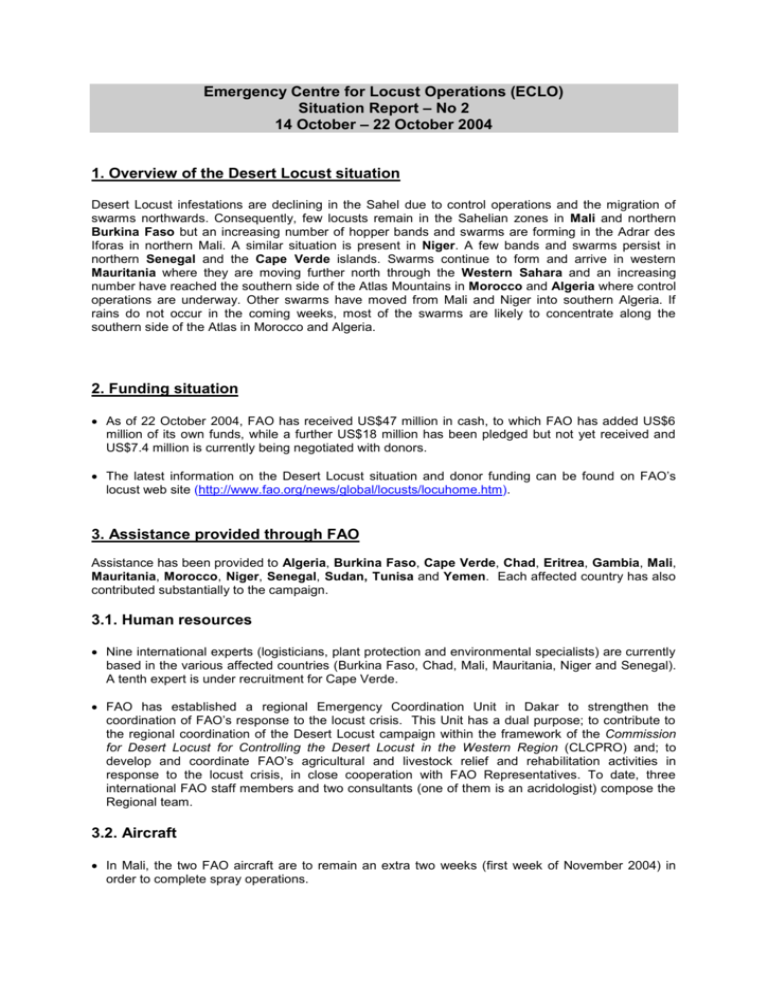
Emergency Centre for Locust Operations (ECLO) Situation Report – No 2 14 October – 22 October 2004 1. Overview of the Desert Locust situation Desert Locust infestations are declining in the Sahel due to control operations and the migration of swarms northwards. Consequently, few locusts remain in the Sahelian zones in Mali and northern Burkina Faso but an increasing number of hopper bands and swarms are forming in the Adrar des Iforas in northern Mali. A similar situation is present in Niger. A few bands and swarms persist in northern Senegal and the Cape Verde islands. Swarms continue to form and arrive in western Mauritania where they are moving further north through the Western Sahara and an increasing number have reached the southern side of the Atlas Mountains in Morocco and Algeria where control operations are underway. Other swarms have moved from Mali and Niger into southern Algeria. If rains do not occur in the coming weeks, most of the swarms are likely to concentrate along the southern side of the Atlas in Morocco and Algeria. 2. Funding situation As of 22 October 2004, FAO has received US$47 million in cash, to which FAO has added US$6 million of its own funds, while a further US$18 million has been pledged but not yet received and US$7.4 million is currently being negotiated with donors. The latest information on the Desert Locust situation and donor funding can be found on FAO’s locust web site (http://www.fao.org/news/global/locusts/locuhome.htm). 3. Assistance provided through FAO Assistance has been provided to Algeria, Burkina Faso, Cape Verde, Chad, Eritrea, Gambia, Mali, Mauritania, Morocco, Niger, Senegal, Sudan, Tunisa and Yemen. Each affected country has also contributed substantially to the campaign. 3.1. Human resources Nine international experts (logisticians, plant protection and environmental specialists) are currently based in the various affected countries (Burkina Faso, Chad, Mali, Mauritania, Niger and Senegal). A tenth expert is under recruitment for Cape Verde. FAO has established a regional Emergency Coordination Unit in Dakar to strengthen the coordination of FAO’s response to the locust crisis. This Unit has a dual purpose; to contribute to the regional coordination of the Desert Locust campaign within the framework of the Commission for Desert Locust for Controlling the Desert Locust in the Western Region (CLCPRO) and; to develop and coordinate FAO’s agricultural and livestock relief and rehabilitation activities in response to the locust crisis, in close cooperation with FAO Representatives. To date, three international FAO staff members and two consultants (one of them is an acridologist) compose the Regional team. 3.2. Aircraft In Mali, the two FAO aircraft are to remain an extra two weeks (first week of November 2004) in order to complete spray operations. In Mauritania, two of the aircraft that have been working intensively since mid-September have ad their contracts extended for 120 more flying-hours each, bringing their total contribution to 600 flying-hours. Two others (fixed-wing) arrived in Mauritania on 17 October 2004, adding a further 240 flying-hours to the control effort. In Senegal, two aircraft arrived on 13 October 2004 up to carry out 120 flying-hours each. One new contract has been issued for the provision of one aircraft to Chad and one to Niger, each for 120 hours. They are expected to arrive imminently. FAO has contracted helicopters to conduct surveying and spraying activities; two for Mauritania, one for Niger and one for Senegal. Their estimated date of arrival is planned for the 26 October 2004. In Mali, aerial survey and control is ensured through a helicopter provided by the United States. To date, FAO has committed US$4.9 million for both aircraft and helicopters. 3.3. Pesticides, equipment and general operating expenses 3.3.1 Pesticides To date (22 October 2004), FAO has ordered a total of 2,052,150, litres of pesticides: 1,028,350 litres of pesticides have arrived in country, of which 1 018 350 have also cleared customs and have been handed over. An additional 1,023,800 litres of pesticides have been ordered and are in transit or pending confirmation of arrival at port of entry. Total value of orders: US$14.7 million. Table 1: Pesticides; quantities arrived in country and in transit Recipient country Quantities (in litres) Arrived in country Algeria Quantities (in litres) In transit 800 Burkina Faso --- 10 000 Chad 40 000 25 000* Eritrea 15 000 --- Mali 111 800 106 800* Mauritania 613 700 372 650* 11 000 3 000 158 450 25 200* Senegal, Republic of 63 400 480 350* Yemen, Republic of 15 000 Morocco Niger Grand Total 1 028 350 1 023 800 * These quantities include pesticides transferred on loan by Algeria and Morocco, which have been partially handed over to the country. 2 3.3.2 Equipment FAO provided funds for surveying, safety and communications equipment, Global Positioning Systems, spraying equipment, pumps and vehicles. 3.3.3 General operating expenses FAO provides general operating expenses such as fuel, vehicle rental, and daily subsistence allowances for survey and control teams. Table 2: Provision of supplies and services including: equipment, flying-hours, human resources and pesticides, by recipient country Recipient country Total (US $ dollars) spent so far Algeria 48 500 Burkina Faso 158 700 Cape Verde 70 000 Chad 1 019 852 Eritrea 131 153 Gambia, Republic of 112 000 Inter Regional 135 042 Mali 2 961 120 Mauritania 10 700 208 Morocco 938 680 Niger 2 618 202 Regional Unit for Africa 395 656 Senegal, Republic of 5 547 471 Sudan 106 857 Yemen, Republic of 118 983 TOTAL US$25 062 424 The table indicates funds FAO has committed as of 22 October 2004. 3.4. Hectares treated As a result of national, bilateral and multilateral assistance, some 1.5 million hectares have been treated in West Africa since the beginning of the campaign this summer. An additional 116,000 have been treated in Northwest Africa in the past two months. Table 3: Number of hectares treated by country in the summer of 2004 Country Algeria Burkina Faso Cape Verde Chad Libyan Arab Jamahiriya Mali Mauritania Morocco Niger Senegal TOTAL Number of hectares treated 54 839 5 456 1 013 6 801 1 060 335 131 334 815 60 689 187 631 536 707 1 524 142 As reported to FAO up to 22 October 2004. Reporting delays and discrepancies may affect the accuracy of these figures. 3 4. Bilateral assistance From the beginning of the current Desert Locust upsurge, the CLCPRO countries have been very supportive. Algeria, Libya, Morocco and Tunisia have donated and loaned pesticides, aircraft, fuel, vehicles and equipment to combat the locusts. They have also fielded survey and control teams in the most affected countries to strengthen human resources. The Gambia has assisted Mauritania and Senegal with ground-spraying teams, Senegal assisted Mauritania in the same way, while Sudan supplied pesticides and vehicle-mounted sprayers to Chad. Other partners who contributed in kind and in cash include countries, international and regional organizations (including UN agencies), development banks as well as NGOs. Recipient countries are Burkina Faso, Cape Verde, Chad, Mali, Mauritania, Niger and Senegal. Main inputs delivered are as follows: Aircraft have been made available (for transport of pesticides and other goods as well as for survey and spraying operations) by: Brazil, France, Italy (through UNHAS), Libya, Morocco, Portugal, Spain, South Africa, the USA and Turkey. In addition, the World Bank has funded flying-hours in Mali. Equipment (such as sprayers, radios, GPS, protective clothing, camping material, generators etc.) have been donated by or purchased with funds of: the European Community, France, UNICEF, the USA and the World Bank. Vehicles have been loaned or hired by UN agencies (UNDP, UNFPA, UNHCR, UNICEF, WFP) and NGOs (such as Care-Mali). New vehicles were also purchased with funds of the European Community, France, the USA and the World Bank. Pesticides early October, the USA have provided pesticides to Mauritania and Senegal together with the six aircraft (operating at the border of the two countries). They are also delivering 200 000 litres of pesticides (in different lots from 20 to 27 October 2004) in Senegal as a strategic stock available for the whole region. Disclaimer: Information contained in the paragraphs relating to bilateral information is not exhaustive. It depends entirely on what is reported to FAO on bilateral assistance from a variety of sources. FAO cannot take responsibility for accuracy of the information provided by external sources. Countries and donors wishing to provide additional information are strongly encouraged to do so by sending an email to the following address: locusts-assistance@fao.org 5. Coordination 5.1 With donors The FAO Representation in each affected country assists with the collection of information, which allows FAO to implement its coordination role for Desert Locust management. This includes collecting information on the resources funded by the countries themselves and on those that they receive bilaterally FAO encourages countries that provide bilateral assistance to locust-affected countries to share the details as far in advance as possible. This can help to avoid duplication of effort by different donors, and to prevent the over-supply of items such as pesticides that can eventually become obsolete. 5.2. With other partners On 14 October 2004, a video conference took place between the Humanitarian Level Working Group based in New York and the FAO headquarters in Rome. Donors had a chance to familiarize themselves with the Locust upsurge and found it extremely useful. 4 Another video conference is being planned for donors based in Geneva, before the end of October 2004. There is a close and constant coordination among the FAO Representatives based in the field, with the new Emergency Coordination Unit based in Dakar, Senegal and the FAO headquarters. 6. Crop and Food Supply Assessment Missions (CFSAMs) Significant damage has been reported to crops and rangeland in the Sahelian countries. To assess losses and needs for food and agricultural assistance. Joint FAO/WFP and The Comité Permanent inter- États de lutte contre la sécheresse dans le Sahel (CILSS) Crop and Food Supply Assessment Missions (CFSAMs) are currently in progress. The CFSAMs will end on 30 October. Nine countries are being assessed: Burkina Faso, Cape Verde, Chad, the Gambia, Guinea-Bissau, Mali, Mauritania, Niger and Senegal. The results of the missions will be available in November 2004 and will guide decisions whether or not to launch an appeal for assistance. 7. Environment The Pesticides Referee Group (PRG) held its 9th meeting at FAO headquarters in Rome, from the 18 to the 21 October 2004. The PRG is an independent advisory body to FAO that evaluates pesticides for their efficacy in Desert Locust control and their environmental risk. The following recommendations were made: 1) Barrier spraying should be the priority technique applied against locust hoppers (young wingless locust larvae) whenever possible. Instead of spraying the whole area infested by hoppers, strips of vegetation 50 to 100 metres wide are sprayed with large spaces between them where no spray is used. The hoppers in the unsprayed areas march through the sprayed ones become contaminated and die. The technique allows larger areas to be treated more quickly using less pesticide, reducing costs and lessening the environmental risk. 2) The FAO guidelines for Desert Locust control should be regarded as the standard for operational control activities. 3) Industry is urged to submit more dossiers for evaluation of pesticides bearing in mind that at this meeting, no new pesticides have been added to the existing list. 4) Of the listed pesticides, the possibility has been offered to use different dosages when certain conditions are met. For example, when aircraft equipped with track guidance systems are being used, the dosage can be reduced by as much as half without any decrease in efficiency of locust control, making great savings in costs and logistic support. 5) Industry is being requested to provide data on the insecticides concerning pre-harvest intervals and withholding periods in order to protect inhabitants and cattle against possible side-effects after treatment. This is a general safety factor to avoid any risk for local population and husbandry. 8. Outstanding requirements and future prospects The countries at risk in Northwest Africa are preparing for intensive control operations, possibly on a higher scale than the spring of 2004 when 6.5 million hectares were sprayed by Morocco, Algeria, Tunisia and Libya. Some donor funds have been channelled through FAO for North West Africa and the countries are being asked to identify their needs. These may include pesticides, aircraft, 5 vehicles, improved management of locust information and assistance with environmental monitoring. Control operations south of the Atlas Mountains have already begun, with the objective of protecting agriculture in the spring. The distribution and extent of rainfall over the next weeks and months will have a major influence in determining whether the current upsurge continues to grow. 6
